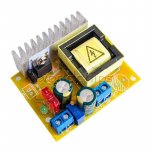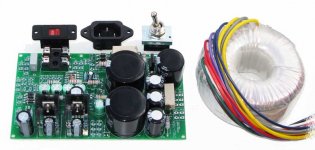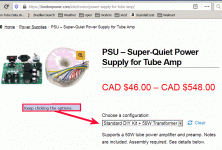For anyone who's following this thread and my experiences with SMPS and boost converters for tube amps...
These are junk. DC-DC 8~32V to 45~390V High Voltage Boost Converter J7E1 Step-up Booster ZV H1V2 | eBay
Don't bother. They are good enough for power/tube testing etc... but even for a 6E2 level meter, simply interfacing it with the rest of the circuit results in power oscillations that sound like a Guinea pig eating albeit an "ear pressed to the speaker" level of noise, but it still bugs makes me angry.
Stick with the ones that don't have "dial-a-volt".
These are junk. DC-DC 8~32V to 45~390V High Voltage Boost Converter J7E1 Step-up Booster ZV H1V2 | eBay
Don't bother. They are good enough for power/tube testing etc... but even for a 6E2 level meter, simply interfacing it with the rest of the circuit results in power oscillations that sound like a Guinea pig eating albeit an "ear pressed to the speaker" level of noise, but it still bugs makes me angry.
Stick with the ones that don't have "dial-a-volt".
Interesting thread! Although I've been registered for a while, this is my first post in this amazing forum, so hello to all!
On this page (translated from Japanese), someone is using that converter for tube amps. He also lists other suitable switched-mode converters (and appropriate mods) for use in tube amps.
He lists also a ready-made one ("DC 12V to 150V-420V DC High Voltage Power PSU Board f Tube amp / Preamp / Filament, about the middle of the page), which has HV output and also for the heaters, all from a 12 V input.
Given the power level of some of these converters, and the great availability of laptop chargers (even from junk), I think 19V should also be an interesting input voltage to consider in this kind of power supply.
On this page (translated from Japanese), someone is using that converter for tube amps. He also lists other suitable switched-mode converters (and appropriate mods) for use in tube amps.
He lists also a ready-made one ("DC 12V to 150V-420V DC High Voltage Power PSU Board f Tube amp / Preamp / Filament, about the middle of the page), which has HV output and also for the heaters, all from a 12 V input.
Given the power level of some of these converters, and the great availability of laptop chargers (even from junk), I think 19V should also be an interesting input voltage to consider in this kind of power supply.
The other advantage is the avoidance of hernia when lifting the supply!
A couple years ago I made a fun little hybrid mini guitar-style amp using
1) mains->12V power blob (switch mode of course) to power the other conveters:
2) an LM2596 buck converter (eBay) for 6.3Vdc heater
3) a 70W 12V->200--450V converter (eBay) for HT
4) a 12V->+/-18V PCB mount DC-DC converter for the opamp front end / phase splitter
So 4 SMPS's for one amp, although if run off a battery only 3 are needed. Only one valve, dual tetrode QQV03-10, so quite a high PSU to valve ratio!
[ This style seem to work, no idea what the real max power is, and they don't like having the output shorted: DC 12V 24V to DC 200-450V 280V 380V High Voltage Boost Step Up Converter 70W | eBay ]
A couple years ago I made a fun little hybrid mini guitar-style amp using
1) mains->12V power blob (switch mode of course) to power the other conveters:
2) an LM2596 buck converter (eBay) for 6.3Vdc heater
3) a 70W 12V->200--450V converter (eBay) for HT
4) a 12V->+/-18V PCB mount DC-DC converter for the opamp front end / phase splitter
So 4 SMPS's for one amp, although if run off a battery only 3 are needed. Only one valve, dual tetrode QQV03-10, so quite a high PSU to valve ratio!
[ This style seem to work, no idea what the real max power is, and they don't like having the output shorted: DC 12V 24V to DC 200-450V 280V 380V High Voltage Boost Step Up Converter 70W | eBay ]
Step Up Inverter for CCDA Preamp
Hi Koda,
Follwing your lead, I am thinking of implementing a step up interver such as the one you've sugested for my Broskies CCDA Octal Preamp . Do I need to add more filter Caps? Or should i use it as it s.
Thanks in advance
DC-AC Converter 12V to 110V 200V 220V 280V 150W Inverter Boost Board Transformer | eBay
Hi Koda,
Follwing your lead, I am thinking of implementing a step up interver such as the one you've sugested for my Broskies CCDA Octal Preamp . Do I need to add more filter Caps? Or should i use it as it s.
Thanks in advance
DC-AC Converter 12V to 110V 200V 220V 280V 150W Inverter Boost Board Transformer | eBay
I drop it in place of the transformer/bridge and use the filter that I'd normally use for a linear supply.
For a CCDA, I'd probably use a main filter like 1k5/220uF after the boost module, but it's probably overkill. Being CCDA, the load shouldn't vary so you should be able to get away with smaller caps..
Koda
For a CCDA, I'd probably use a main filter like 1k5/220uF after the boost module, but it's probably overkill. Being CCDA, the load shouldn't vary so you should be able to get away with smaller caps..
Koda
Thank you
Koda,
Thanks for the quick reply. I've ordered a 12v led driver and the step up inverter per your recommendation. That should be plenty for a low load 2 octal tubes pre amp. The board is coming in from the East. It should arrive in about 2 weeks or so. Can't wait.
I appreciate people who are able to think outside of the norm.
Thanks again,
Koda,
Thanks for the quick reply. I've ordered a 12v led driver and the step up inverter per your recommendation. That should be plenty for a low load 2 octal tubes pre amp. The board is coming in from the East. It should arrive in about 2 weeks or so. Can't wait.
I appreciate people who are able to think outside of the norm.
Thanks again,
Hi, I'm trying to use a cheap DC-DC 8~32V to 45~390V step-up converter to supply a little tube amp, fed with an ATX 500W PSU. Voltage and current required are 160v/150mA. As soon as powered I noticed hiss noise at the output due to the switching frequency (I don't hear hum at all), so I wondered what kind of RC filter could do the job....can I assume a 20 KHz switching frequency for devices?
Attachments
Somewhere around there... If you use a large RC filter (maybe like 220R/220uf?) or an LC filter (I use 4H/220uF) you might quench it. Personally, I gave up on that particular type of supply because it's noisy.
The one linked in post #44 would work without the noise, and you can use ohms law to figure out what resistance to use to drop 40V from the 200V you'd set it to.
The one linked in post #44 would work without the noise, and you can use ohms law to figure out what resistance to use to drop 40V from the 200V you'd set it to.
Last edited:
Yes, I read your old post. In first instance I tried a 22R/220uF filter (I had at hand this one) and things seemed much better with only a residual hiss appearing in a channel. But I think the problem is the cheap SMPS not the best for supply tubes maybe...
This one in particular is marginal. I've used it for a phono stage with success before, but I feel 160mA@150V might be pushing it for this supply. It was struggling with 25mA@330V...
By the way, I found in your country this one:
Quiet Power Supply for Tube Amp - Tube Amp Kits by London Power
Although not so cheap, it would seemed to be SMPS...but I'm not sure.
Quiet Power Supply for Tube Amp - Tube Amp Kits by London Power
Although not so cheap, it would seemed to be SMPS...but I'm not sure.
> seemed to be SMPS...but I'm not sure.
Keep clicking the options.

It is a plain old linear supply with 50/60Hz transformer.
The transistors on fins are for Kevin's variable-voltage scheme to make big guitar amps distort at less loud level.
Yes, I realized then it by a better reading...with the TX furnished, the big caps and mosfets it could be only that.
> seemed to be SMPS...but I'm not sure.
Keep clicking the options.

It is a plain old linear supply with 50/60Hz transformer.
The transistors on fins are for Kevin's variable-voltage scheme to make big guitar amps distort at less loud level.
...@PRR - Might you have a link for both the board/tranny above, as well as the referenced "Kevin's variable-voltage...guitar-amp...distort at lower level" comment?
Thanks very much!
> @PRR - Might you have a link for both the board/tranny above
There's no direct link; different options give different choices and images. Keep clicking the options!
There's also technical papers on the site carefully explaining Kevin's techniques.
There's no direct link; different options give different choices and images. Keep clicking the options!
There's also technical papers on the site carefully explaining Kevin's techniques.
Attachments
Just an FYI for those who are interested...
If you use this, you can use the 18V winding to boost or buck for more voltage choices.
500W 12VDC transfer 18VAC & 0-220v-380v inverter module | eBay
Yesterday, using the 160V winding into a doubler, and using an ATX supply that can sag, I was getting 277V out. Today I configured it to boost by 18V and I now have 313V just like I should.
For every 1V difference in input voltage, the output of 380V (full winding) changes by ~32V
In addition to the 160 220 and 380 volt outputs it comes with, you also get 142 172 202 238 362 and 398 volts, too (depending on if you boost or buck) and that doesn't count using a doubler.
Also, the one I measured today runs at 21.8 kHz if anyone cares.
Koda
If you use this, you can use the 18V winding to boost or buck for more voltage choices.
500W 12VDC transfer 18VAC & 0-220v-380v inverter module | eBay
Yesterday, using the 160V winding into a doubler, and using an ATX supply that can sag, I was getting 277V out. Today I configured it to boost by 18V and I now have 313V just like I should.
For every 1V difference in input voltage, the output of 380V (full winding) changes by ~32V
In addition to the 160 220 and 380 volt outputs it comes with, you also get 142 172 202 238 362 and 398 volts, too (depending on if you boost or buck) and that doesn't count using a doubler.
Also, the one I measured today runs at 21.8 kHz if anyone cares.
Koda
Very interesting stuff. A couple of questions:
1. How much current/power can you get out of these things? It says 500W. Can you get anywhere that much with the incuded heatsink?
2. Is the high voltage output isolated from the input or does it have a common ground?
3. Have you looked at the bigger supplies like this one? It's mentioned in the other thread.
1/2/4Pcs 7R 230W 5R 200W Moving Beam Head Light Ballast Power Supply Disco | | eBay
They are only advertised as 200w but seem to have a much larger heatsink and they operate off line voltage so no ATX supply needed.
1. How much current/power can you get out of these things? It says 500W. Can you get anywhere that much with the incuded heatsink?
2. Is the high voltage output isolated from the input or does it have a common ground?
3. Have you looked at the bigger supplies like this one? It's mentioned in the other thread.
1/2/4Pcs 7R 230W 5R 200W Moving Beam Head Light Ballast Power Supply Disco | | eBay
They are only advertised as 200w but seem to have a much larger heatsink and they operate off line voltage so no ATX supply needed.
I've run it at 200W and the heat sink is only about 40c inside a chassis.
The ones I listed are all isolated, I use one for C- bias supply.
I believe the one you listed is not isolated, as the HV output comes from the line side of the board. It could be used with an isolation transformer, but then you could just use that for a power transformer and negate the SMPS in the first place.
The ones I listed are all isolated, I use one for C- bias supply.
I believe the one you listed is not isolated, as the HV output comes from the line side of the board. It could be used with an isolation transformer, but then you could just use that for a power transformer and negate the SMPS in the first place.
- Home
- Amplifiers
- Power Supplies
- Kanged switching power supply for a tube amp


